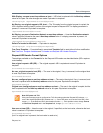
Device Management
Polycom, Inc. 110
Next hop address Fully qualified domain name (FQDN), host name, or IP address of the peer
server.
If you specify a domain/host name, the system routes calls to this peer by
using DNS to resolve the address. The DNS server that the system uses must
contain the required records (NAPTR, SRV, and/or A/AAAA).
Note: If you are configuring a Lync 2013 SIP Peer, the Next hop address
should be the FQDN or IP address of the Lync Pool, not an individual Lync
server within a pool.
Destination network Host name, FQDN, or network domain label of the SIP peer, with or without
port and URL parameters.
If specified, this value by default replaces the non-user portion of a URL (after
the @ symbol) of the To header and Request-URI for forwarded messages,
and just the Request-URI for REGISTER messages.
If Type is set to Microsoft, this field is required and is used for the peer’s
domain.
Note: This field is used as the SIP domain for Polycom RealConnect
™
conferences.
Port The SIP signaling port number. Defaults to the standard UDP/TCP port, 5060.
If the peer server is using a different port number, specify it.
Note: For a Microsoft Lync 2013 SIP peer, the port should be 5061.
If left blank, the system uses the full RFC 3263 procedure to determine the
port via DNS.
Transport type The transport protocol to use when contacting this peer server. The default is
UDP.
Auto detect tells the system to select the protocol as specified in RFC 3263,
and is not valid if Next hop address is a numeric IP address instead of a
host/domain name.
Use route header Add a Route header with the peer’s Next hop address value to the message.
Applies to both forwarded messages and external REGISTER messages.
If not selected, the only valid Request-URI configurations are those that use
the peer's Next hop address value for the URI host.
Note: Disable this option for Microsoft Lync SIP peers that will accept content
sessions from Polycom RealPresence Content Sharing Suite applications
through the RealPresence DMA system.
Downgrade If selected, and if this peer doesn’t support TLS, the system can change the
Request-URI schema from sips to sip and route the call to this peer.
If not selected, the system routes a TLS call to this peer only if this peer
supports TLS.
Field Description


















